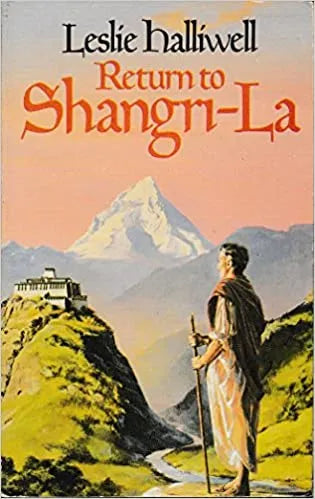
Who weaves our dreams of illusion? ▎Shangri-La (part1)

Who weaves our dreams of illusion?

The Lost Horizon
In 1933, young British novelist James Hilton rose to fame with his novella "Lost Horizon." He won the Hawthorden Prize that same year, which is awarded to imaginative British novelists under the age of 41 and is considered equivalent to the Pulitzer Prize in the United States.



Even more surprising, the valley is cleverly decorated with small grasslands and cheerful gardens, painted tea houses and toy-like houses nestle beside the streams; the Shangri-La temple lies quietly among them, a cluster of colorful pavilions and towers nestled compactly on the mountainside, like petals exquisitely and elegantly set on the cliff, appearing luxurious and elegant.


Miss Brinklow, self-assured and stubborn, devoted everything to her faith, intending to convert all the residents of Shangri-La. And Barnard, a victim of the Great Depression, secretly rejoiced in finding a very safe hiding place, and upon discovering a gold mine in the area, began to weave new dreams of wealth...


Shangri-La
After winning the prestigious Hawthorn Award, "The Lost Horizon" became extremely popular and a bestseller in various countries. By the end of 1936, the book had already been reprinted 15 times, with total sales exceeding 70,000 copies. In response to reader demand, the book was reprinted multiple times in paperback, hardcover, pocket-sized, and abridged editions by renowned publishers such as William McMahon, Macmillan, The Reader's Digest Association, and Summersdale. To date, the book has been reprinted over a hundred times.







The book was published in 1933, at a time when economic crises were raging in Western countries and World War II was looming on the horizon. Young people who had once harbored dreams and ambitions of participating in World War I had their hopes and dreams shattered by the brutalities of war. The Great Depression, which began in 1929, forced millions of people to live like animals in order to survive. It is easy to imagine the mental state of individuals whose bodies and minds were being tortured by the ravages of war and the dire living conditions.
Westerners, whose spirits had been battered by the turmoil they endured, longed for solace in the peaceful paradise of Shangri-La.
Just as the High Lama of Shangri-La foresaw the impending war, he spoke prophetically about how war would trample on all cultures and beauty:
"He also foresaw the coming of an age when men would boast of their prowess in killing, and so rampant would it become on this earth that everything of worth – the paintings, the harmonious gestures, the precious objects treasured for two thousand years, and all that was gentle, fine and fragile – would be gone."

The film opens with the following off-screen narration introducing the story that captivated countless Westerners:
In today's world full of war and lies, do you dream of a peaceful and happy life, free from struggles, and filled with continuous joy?
Of course, you do, as humans have always done!
This shared dream, some call it utopia, some call it the fountain of youth, but there is one person who embraces this dream and sees it come true...


Dream Illusion
Once the movie was released, it broke the box office record for three consecutive years, causing a sensation worldwide with its spectacular scenery, excitement, romance, wonder, and passion. As a devoted movie fan, American President Roosevelt even named his secret vacation spot "Shangri-La".
Years later, the movie was introduced to China under the name "Peach Blossom Spring", bringing a ray of spiritual comfort to countless war-weary people. The Chinese producer meticulously created the film, and the theme song "Shangri-La" sung by the popular singer Ouyang Feiying was the highlight. Her nightingale-like voice quickly spread throughout the country:
Look at the mountains and waters meet
Look at the red walls and green tiles
It's like a myth embellished
Look at the willow branches in disarray
Look at the flowers budding low
Clearly a colorful painting
And the warm spring breeze
Is more like a light veil
We are under its canopy
We sing
We laugh
This beautiful Shangri-La
This lovely Shangri-La

In the 1990s, backpackers, scholars, and officials alike claimed to have found their own Shangri-La. Bars and cafes bearing the name of Shangri-La could be found in places like Ladakh, the Hunza Valley in Pakistan, Bhutan, the town of Muktinath in Nepal, Daocheng in Sichuan, Bingzhongluo in Yunnan, Lijiang, and Zhongdian. After much debate, the controversy was finally resolved with the renaming of Zhongdian County in Diqing, Yunnan to "Shangri-La."

Additional remarks
Today's "Shangri-La" is no longer the bourgeois paradise that Western youth sought in the last century, but it is also not a tangible, religiously colored heaven. It has long become a spiritual home for every helpless soul, a mental villa for every lost youth. Everyone has their own Shangri-La, and everyone walks alone on the path to find their own Shangri-La. Just as Hilton wrote in the brilliant conclusion of the book:
We sat down, facing each other in silence for a long time. Later, I started talking about my memories of Conway, the young man who was innocent, exceptionally talented, resilient. I talked about the war that changed him, the very old Manchu girl, and the mystical and elusive dream of the blue moon.
Do you think he will find Shangri-La?

Will you be able to find Shangri-La?
